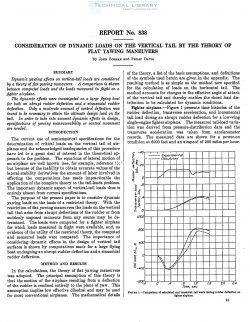naca-report-838

- Version
- 162 Downloads
- 460.26 KB File Size
- 1 File Count
- August 31, 2016 Create Date
- August 31, 2016 Last Updated
National Advisory Committee for Aeronautics, Report - Consideration of Dynamic Loads on the Vertical Tail by the Theory of Flat Yawing Maneuvers

Dynamic gaining ejects on vertical-tail loads are considered
by a theory of flat yawing maneuvers. A comparison is shown
between computed loads and the loads measured in flight on a
fighter airplane.
The dynamic effects were investigated on a large flying boat
for both an abrupt rudder deflection and a sinusoidal rudder
deflection. Only a moderate amount of control deflection was
found to be necessary to attain the ultimate design load on the
tail. In order to take into account dynamic effects in design,
specifications of yawing maneuverability or control movement
are needed.
The current use of semiempirical specifications for the
determination of critical loads on the vertical tail of air-
planes and the acknowledged inadequacies of this procedure
have led to a great deal of interest in the theoretical ap—
proach to the problem. The equations of lateral motion of
an airplane are well known (see, for example, reference 1);
but because of the inabilityto obtain accurate values of the
lateral stability derivatives the amount of labor involved in
efiecting the computations has made impracticable the
application of the complete theory to the tail-loads problem.
The important dynamic aspect of vertical-tail loads thus is
entirely absent from current specifications.
The purpose of the present paper is to consider dynamic
yawing loads on the basis of a restricted theory. With the
restriction of flat yawing maneuvers the loads on the vertical
tail that arise from abrupt deflections of the rudder or from
suddenly imposed moments from any source may be de—
termined. The loads were computed for a fighter airplane
for which loads measured in flight were available, and, as
evidence of the utility of the restricted theory, the computed
and measured loads were compared. The importance oi
considering dynamic effects in the design of vertical tail
surfaces is shown by computations made for a large flying
boat undergoing an abrupt rudder deflection and a sinusoidal
rudder deflection.
| File | Action |
|---|---|
| naca-report-838 Consideration of Dynamic Loads on the Vertical Tail by the Theory of Flat Yawing Maneuvers.pdf | Download |

Comment On This Post